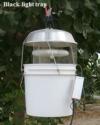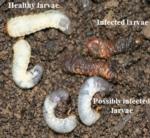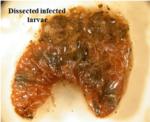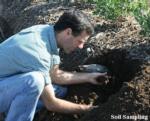Development of Management Programs for White Grubs in California Blueberries
During the past few years, white grubs have become recognized as a pest of southern highbush blueberries in California. White grubs feed on plant roots causing the plant to be stunted. In some cases, plant death has occurred when large grub populations attack newly planted fields. The predominant white grub species in California blueberries was identified as Cyclocephala longula. Research on flight characteristics determined that grubs are primarily in the third instar in April, pupate in May, and fly from mid-June through mid-July. Egg hatch begins in mid-July. Adult beetles begin flying about 30 min after dark and can be collected for a period of about 2 hours with black-light traps. Evaluation of control methods found that the entomopathogenic nematode Heterorhabditis bacteriophora and the insecticide imidacloprid can both provide control of the grub. Applications of Heterorhabditis bacteriophora on April 1 initially only provided 8.3% control, but resulted in secondary spread that led to an epizootic within the grub population. Applications of Heterorhabditis bacteriophora and imidacloprid in August resulted in 81.6 and 71.1% control, respectively, the following June.
Websites
White Grub Documents







